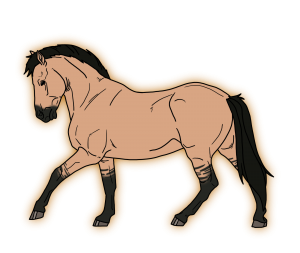Difference between revisions of "Treivan Wild Horse"
RedAttendant (talk | contribs) (Created page with "thumb The Treivan Wild Horse is the only true wild horse species remaining in Aversia. There were likely others that existed in Aversia's hi...") |
RedAttendant (talk | contribs) m |
||
| Line 50: | Line 50: | ||
[[Category:Common]] | [[Category:Common]] | ||
[[Category:Tameable]] | [[Category:Tameable]] | ||
| + | [[Category:Passive]] | ||
Latest revision as of 01:46, 26 April 2021
The Treivan Wild Horse is the only true wild horse species remaining in Aversia. There were likely others that existed in Aversia's history, but a mix of of other prey species overtaking them, and the rise of the domestic horse, all but the Treivan have gone extinct.
The Treivan is smaller than most domestic breeds, usually only about 13.7 - 14.2 HH (140 - 145 cm, 55 - 57 in), and weighing in at around 272.1 - 294.8 kilos (600 - 650 lbs). They are incredibly hardy horses despite their size; they are stocky and strong and one of the only horses known to be able to climb rocky hills and small mountains without too much trouble. They are, however, not as fast as other species, usually relying on kicking predators to escape rather than fleeing at high speed.
Their coat colors are rather basic colors; black, bay, dun, grullo (blue dun), and appaloosa, although the appaloosa pattern is quite rare. They have primitive markings, such as a dorsal stripe, leg bars, and a shoulder stripe, and this is seen even in appaloosa patterned horses. Their manes are almost always short, and stand up along their necks, rather than fall over their neck, like what is seen in most domestic horse breeds. Some horses also have light feathering above their hooves, but this is uncommon. Unless crossed with domestic horses, or from a line kept in captivity for several generations, the Treivan wild horse does not have white markings.
Treivans are true wild horses, and as a result, take a skilled hand to handle them. They require a lot more work to become a usable horse, and in most cases, they are only kept for breeding purposes, rather than for work. They are most often used to add certain traits to other breeds, such as their stocky stature, or their ability to climb. A working horse is best captured when young, and needs to be handed carefully so as not to instill a fear of people.
Distribution
The Treivan Wild Horse are found among grasslands which tend to be near the more rough terrain of mountainous regions. Some may range uncommonly towards the south, where the horses have been kept for breeding purposes yet released into the lands. Their numbers are relatively small due to competition with other prey animals, and domestic horses, however are considered to still be quite common.
Habitat
Treivans are a highly nomadic species, rarely staying in one place for long, but they are most commonly found grazing in open plains. At night, they will often gather under a grove of trees to keep warm or shelter from the wind by staying near steeper cliffs, but will move on once the sun rises again.
Diet
Like all other horses, the Treivan is a herbivore. The bulk of their diet is plains grasses, along with some flowers and other plants they may pick up while grazing. They do best in captivity when they're pastured and not put in a stall and fed hay and grain.
Relations
Treivan wild horses are just like any other wild animal in that they are nervous around Aversia's sentient races; they see them as predators, and will put as much distance between them and the person approaching. It's not uncommon for herd stallions to attack if there's only one or two people getting too close for comfort. They are less reactive when approached on horseback, and that is how most horses are captured, rather than by hunters on foot.
It is not uncommon for the wild horses to be hunted for their meat or fur. They are also sometimes considered to be pests, as they will compete with domestic livestock for grazing space.
Mechanics
- Agile; able to climb rocky slopes
- Relatively small but strong
- Low speed
- Very hard to domesticate
- Do best in temperate climates
Material Properties
- Their meat and fur are the most harvested parts.
- Hair from their tail can be used in string instruments, although the horse does not need to be killed for it to be collected.
Alchemical Properties
- Undiscovered; likely none.
| Geography • Races • Flora • Fauna • Stones • Metals • Cloth • Foreign Continents |
| The World of Aethius • The Multiverse of Aethier |
